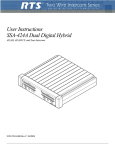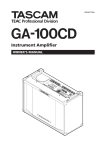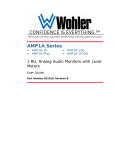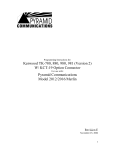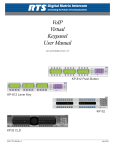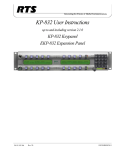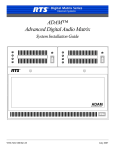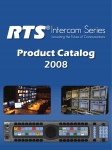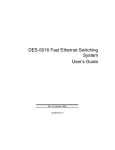Download RTS KP95 Installation guide
Transcript
ADAM™ CS Advanced Digital Audio Matrix System Installation Guide ADAM CS TM Advanced Digital Audio Matrix POWER GOOD 9330-7517-000 Rev H POWER GOOD July 31, 2006 PROPRIETARY NOTICE SHIPPING TO THE MANUFACTURER The product information and design disclosed herein were originated by and are the property of Telex Communications, Inc. Telex reserves all patent, proprietary design, manufacturing, reproduction, use and sales rights thereto, and to any article disclosed therein, except to the extent rights are expressly granted to others. All shipments of product should be made via UPS Ground, prepaid (you may request from Factory Service a different shipment method). Any shipment upgrades will be paid by the customer. The equipment should be shipped in the original packing carton. If the original carton is not available, use any suitable container that is rigid and of adequate size. If a substitute container is used, the equipment should be wrapped in paper and surrounded with at least four (4) inches of excelsior or similar shock-absorbing material. All shipments must be sent to the following address and must include the Proof of Purchase for warranty repair. Upon completion of any repair the equipment will be returned via United Parcel Service or specified shipper, collect. COPYRIGHT NOTICE Copyright 2006 by Telex Communications, Inc. All rights reserved. Reproduction, in whole or in part, without prior written permission from Telex is prohibited. WARRANTY NOTICE See the enclosed warranty card for further details. CUSTOMER SUPPORT Technical questions should be directed to: Customer Service Department RTS/Telex Communications, Inc. 12000 Portland Avenue South Burnsville, MN 55337 USA Telephone: 800-392-3497 Fax: 800-323-0498 Factory Service: 800-553-5992 RETURN SHIPPING INSTRUCTIONS Customer Service Department Telex Communications, Inc. (Lincoln, NE) Telephone: 402-467-5321 Fax: 402-467-3279 Factory Service: 800-553-5992 Please include a note in the box which supplies the company name, address, phone number, a person to contact regarding the repair, the type and quantity of equipment, a description of the problem and the serial number(s). Factory Service Department Telex Communications, Inc. 8601 East Cornhusker Hwy. Lincoln, NE 68507 U.S.A. Attn: Service This package should include the following: Table of Contents Chapter 1 Introduction and Installation .............................................................................................................................3 ADAM CS Front Panel .....................................................................................................................................3 ADAM CS Back Panel .....................................................................................................................................3 ADAM CS Frame Installation ..........................................................................................................................4 Circuit Cards .....................................................................................................................................................4 Card Installation and Removal .........................................................................................................................4 Unused Card Slots ............................................................................................................................................4 Card Reset and Fail Indication .........................................................................................................................4 Audio I/O Card Notes .......................................................................................................................................4 Master Controller Notes ...................................................................................................................................5 Power Supply Removal /Installation ................................................................................................................5 AC Power Connection ......................................................................................................................................5 Chapter 2 Operation ..........................................................................................................................................................7 System Power Up .............................................................................................................................................7 Alarm Operation ...............................................................................................................................................7 Computer Connection .......................................................................................................................................7 Software Installation .........................................................................................................................................8 Intercom Port Connections ...............................................................................................................................8 General Information ..........................................................................................................................................8 Logical Keypanel Address Numbers ................................................................................................................8 General Procedure for Connecting Devices to Intercom Ports .........................................................................8 Trunking System ...............................................................................................................................................9 General Theory of Operation ............................................................................................................................9 UIO-256 Input/Output Frame .........................................................................................................................10 General Description ........................................................................................................................................10 General Theory of Operation ..........................................................................................................................10 UIO-256 Connection ......................................................................................................................................10 One UIO-256 ..................................................................................................................................................10 Additonal UIO-256s .......................................................................................................................................11 KP-32 Addressing ...........................................................................................................................................20 List of Tables ADAM CS, J903 Connector Pinout ......................................................................................................................15 ADAM CS Master Controller Card DIP Switch Settings (S1) .............................................................................19 Relationship between Audio Input/Output Cards, Intercom Ports, and Logical Keypanel Numbers ..................20 Address Switch Settings for KP-95/96/97/98 Keypanels and the TIF-2000 Telephone Interface .......................20 UIO-256 DIP Switch SW1 Setting for Input/Output Range ................................................................................21 UIO-256 GPI Outputs Connectors (J5) ................................................................................................................21 UIO-256 GPI Inputs Connector (J7) .....................................................................................................................22 Planning Worksheet for ADAM CS with RJ-11 or DE9 Back Panel ...................................................................23 Planning Worksheet for ADAM CS with 50-pin Telco Back Panel ....................................................................25 List of Figures ADAM CS Front View ......................................................................................................................................... 11 ADAM CS Back View (Shown with RJ-11 Connector Panel) ............................................................................ 12 ADAM CS J900 to Computer Interconnect Cables (ADAM CS with male J900 Connector) ............................. 13 ADAM CS J900 to Computer Interconnect Cables (ADAM CS with female J900 Connector) .......................... 13 RJ-12 Intercom Keypanel Cable ........................................................................................................................... 14 9-pin Intercom Keypanel Cable ............................................................................................................................ 14 RJ-11 to 9-pin Intercom Cable. Used for TIF connection to ADAM CS with RJ-11 Back Panel ....................... 15 Cable for Connection of a UIO-256 or a Program Assign Panel ......................................................................... 16 Using an ADAM CS GPI Output to Operate a Relay (See Table 1 on page 15 for GPI Connector Pin-out) ...... 16 Using an ADAM GPI Input (See Table 1 on page 15 for GPI Connector Pin-out ............................................... 17 CDP-950 Cable Wiring Diagrams ........................................................................................................................ 17 50-Pin Telco Cable Wiring Diagram .................................................................................................................... 18 CHAPTER 1 Introduction and Installation NOTICE: These servicing instructions are for use by qualified personnel only. To avoid electric shock do not perform any servicing other than that contained in the Operating Instructions unless you are qualified to do so. ADAM CS Front Panel There are 10 card slots in the front panel. Starting from the left side, slots 1 through 8 are for Audio Input/Output (AIO) Cards. Slots 9 and 10 are for main and backup Master Controller Cards. The two large bays at the right side of the front panel contain main and backup power supplies. These power supplies are mounted in shuttles which may be pulled out for quick access/replacement. The power supplies are designed for automatic switch-over in the event of a power supply failure. There is an audible alarm for indication of power supply failure. An alarm override switch lets the user turn off the audible alarm after notification, allowing the affected power supply to be replaced at a later time. ADAM CS Back Panel There are two fused AC Power connectors with ON/OFF switches. The AC1 connector porvides power to the PS1 power supply. The AC2 connector provides power to the PS2 power supply. Four AC-powered fans along the top of the back panel provide cooling for the power supplies and circuit cards. Either AC ON/ OFF switch will activate the cooling fans and the associated power supply. The bottom half of the back panel is reserved for the connector panel. Three styles of connector panels are available, offering a choice of intercom port connectors: RJ-11, 9-pin male D-sub, or 50-pin Telco. At the left side of the connector panel are four additional connectors: J900 DE-9S female) connector for RS232 connection to a personal computer. J901 DE-9S Connector for RS485/232 connection to an RTS Trunking System J902 DE-9S Connector for RS485/232 connection of Program Assign Panels, LCP-102 Level Control Panels, and UIO-256 Universal Input/Output Frames J903 DB-25S (female) connector for general purpose interface. Provides eight, open-collector digital inputs and eight relay outputs. 3 Introduction and Installation ADAM CS Frame Installation The ADAM CS Frame is equipped with rubber feet for placement on a desktop. For installation in an equipment rack, it may be necessary to remove the feet. Verify that the ventilation holes on the front and back are not obstructed. Allow space in back for attachment of connectors (at least 24 inches). Circuit Cards Card Installation and Removal READ THIS BEFORE INSTALLING CIRCUIT CARDS! The connector pins on the back plane inside the ADAM CS frame can be easily damage by improper or hurried insertion of circuit cards. Always use the folllowing procedure when installing cards: 1. Insert the card edges into the upper and lower card guides in the frame. 2. SLOWLY push the card straight back into the slot until intitial resistance is felt. 3. When initial resistance is felt, apply slightly more pressure to begin engaging the connector pins. 4. Once the connector pins have started to engage press FIRMLY to completely seat the connectors. When the card is properly seated, the card plate on the front of the card should be flush with the front of the ADAM CS frame, and the ejector levers on the card plate should be in the horizontal position. To remove a card, press down on the lower ejector lever and up on the upper ejector lever. Once the card is released from the back plane connector, pull it straitght out of the frame. Cards should be secured in the frame at top and bottom with the screws provided. Otherwise, vibration of the frame could cause the cards to loosen over time. NOTE: All ADAM CS circuit cards can be removed or installed while the equipment is operating. This permits continuous operation of the intercom system, with no interruptions, in the event of any card failure. Unused Card Slots To ensure proper air flow, each unused front card slot should be fitted with a card blank (p/n 9000-7467-003) to cover the opening. Card Reset and Fail Indication Each circuit card is equipped with a reset switch located near the top-front of the card. Directly under the reset switch is a red fail indicator. The fail indicator remains off during normal operation. If the fail indicator turns on, first attempt to restor normal operaton by moentarily pressing the reset button. Allow 15 to 30 seconds for reset. If the fail indicator does not turn off after this time, check that the card is properly seated, or replace the affected card. Audio I/O Card Notes • When an Audio I/O card is removed during normal operation, the displays on any keypanels connected to that card will display asterisks instead of the normal key assignments. After a card is reinstalled, it may take a few moments for the keypanel displays to return to normal. • All system clock signals are derived from the Audio Input/Output Card in slot number 5, with the clock backup provided by slot number 4. Therefore, if your intercom system uses fewer than eight AIO cards, make sure that slots 4 and 5 are filled with a card. Also, never remove cards 4 and 5 at the same time, as the intercom system will cease to operate. 4 Power Supply Removal /Installation Master Controller Notes • As shipped from the factory, all master controller card DIP switches are set for default operation. These settings will be satisfactory for most applications. Optional settings are summarized in Table 2, “ADAM CS Master Controller Card DIP Switch Settings (S1),” on page 19. If you change any settings, make sure both the main and backup master controller cards are set the same. Power Supply Removal /Installation To install a power supply, insert the metal flanges on the top and bottom of the shuttle into the upper and lower guides in the frame. Push the shuttle into the slot until it is firmly seated. Tighten the captive screws. AC Power Connection 1. Place the AC switches on the back panel of the ADAM CS frame in the OFF (O) position. 2. Place the power supply on/off switch on the front of each power supply in the OFF (o) position. 3. Connect the AC power to both of the AC jacks on the back of the ADAM Frame. Connecting both AC inputs will insure continued operation of the ADAM CS Frame in the event that one power supply fails. If desired, two separate AC power phases may be connected. This will protect not only against a power supply failure, but also against a loss of power to one phase. 5 Introduction and Installation 6 CHAPTER 2 Operation System Power Up NOTE: For proper power supply loading, at least two circuit cards should be installed in the frame before turning on the power supplies. 1. Place the AC switches on the back of the ADAM CS Frame in the ON position. The AC fans should turn on. 2. Place the ALARM OVERRIDE switch on the front panel in the center position. 3. Place the on/off switch on the front of each power supply in the ON position. The POWER indicators and all the voltage indicators should be lit. While the intercom system is initializing, the red fail indicators will be lit on all circuit cards. Allow 15 to 30 seconds for all fail indicators to turn off. NOTE: If the system fails to initialize, make sure that all circuit cards, especially the cards in slots 4 and 5, are properly seated. Alarm Operation If there is a power supply fault during operation, an audible alarm will sound and one or more indicator lights on the affected power supply will turn off. To deactivate the alarm, set the ALARM OVERRIDE switch to the position for the affected supply. Turn off the defective supply, and repair or replace it as soon as possible to ensure continued backup protection in the event of another power supply failute. NOTE: The power supply alarm will also sound if a power supply is not turned on. This is normal. Either turn on the power supply, or set the ALARM OVERRIDE switch. Computer Connection Connect from J900 on the ADAM CS Frame to COM1 or COM2of the configuration PC (the default for AZedit is COM1). The interconnect cable is null modem cable, the wiring is shown in Figure 3 on page 13. 7 Operation Software Installation Now that the ADAM CS frame is operating and the configuration computer is connected, you are ready to install the AZedit software and verify the computer can communicate with the intercom system. Follow the directions to install the software that accompanied the AZedit CD. AZedit gives you online help after starting the software. When the keypanel setup screen appears (the default setup screen), press F1 to start help, then select “Help Contents”. When the “Contents” screen appears, select “General Procedure to Configure the Intercom System”. Once the software is installed, you can begin connecting intercom stations and other devices to the intercom system as described in the following paragraphs. Intercom Port Connections General Information Each intercom port uses two wires for audio input, two wires for audio output, and two wires for data. Depending on the type of device being connected, some pairs of wires may not be used. The audio input and output wires typically provide the talk and listen connections for an intercom station, but other types of audio devices could also be connected. For example, a program source could be connected to the audio input wires, and in this case the audio output wires would be available for other uses. The data wires are used to send and receive control information between the connected device and the Master Controller in the ADAM CS frame. The data wires are only used by keypanels, by the TIF Telephone Interface, and by the CDP-950 Camera Delegate Panel. The type of data transmitted includes key pressed information and display information. For example, when a key is pressed on a keypanel, this information is sent on the data wires to the ADAM CS frame. The Master Controller in the ADAM CS frame then routes the audio to the proper destination as defined in the intercom system’s configuration program. The Master Controller also sends data to the device being called; for example, to display the caller’s name at a keypanel, or to activate a telephone line at the TIF Telephone Interface, etc. Logical Keypanel Address Numbers Even though there are separate data pins for each intercom port, these pins do not actually represent a unique data port. Rather, groups of intercom ports share a common data port. In an ADAM CS intercom system, data groups consist of 8 intercom ports, and each Audio Input/Output Card represents 1 data group. To distinguish between data devices connected to the same data group, a logical keypanel address number (1-8) is assigned to each device at the time of connection. The relationship between intercom port numbers, Audio I/O card numbers and logical keypanel address numbers is shown in Table 3 on page 20. Specific information about setting logical keypanel address numbers is discussed in the installation notes on the following pages. General Procedure for Connecting Devices to Intercom Ports The following is a suggested method for connecting devices to intercom port: 1. Make a copy of the appropriate planning worksheet. For ADAM CS frames that use RJ-11 or DE-9 back panels, use Table 8 on page 23. For ADAM CS frames that use a 50-pin telco back panel, use Table 9 on page 25. 2. For each device that will be connected, fill in a row on the worksheet: 8 Trunking System • Briefly note the device type (keypanel, TIF, program source, CDP-950, etc.). Other useful information might include the device location and usage, as well as any labeling on the intercom cable. • Write down a name of up to eight characters in the “Alpha” column of the worksheet. You will enter this name inot the intercom system later using AZedit. Then, whenever you assign the port to an intercom key, the name will appear in the keypanel display for that key. • If the intercom system uses optional trunking (where two or more intercom system are interconnected and users can intercommunicate using special equipment) you may wire a second name in the “Alias” column of the work sheet, if desired. An alias may be useful, for example, to prevent confusion when the same alpha name is already being used by two intercom ports located in separate intercom systems. When one of these ports in one intercom system is assigned to a keypanel key in the other intercom system, the alias name, and not the alpha name will appear in the display. NOTE: In AZedit, you can enter Alias names at the same time as you enter Alpha names. If you do not enter an Alias name, AZedit will automatically use the Alpha name as the default. By default, AZedit is not configured for turnking operation. If you want to enter Alias names and use trunking with AZedit, you must enable trunking. WARNING: Enabling trunking will erase the system setup and erase all data. SAVE your file set before enabling trunking. To enable trunking, do the following: a.From b. 3. the Options menu, select Preferences, and then Advanced page. On the Advanced page, select Enable Trunking Support. Once you have made this change, you will be able to enter alias names in AZedit. Connect devices to the intercom ports as noted in the worksheet. For each type of device, refer to any installation notes included on the following pages. Or, refer to the installation information supplied with the device. The ADAM CS frame with a 50-pin Telco back panel can be connected to any of the folliwng breakout formats: punch blocks jack fields XCP-954-618 XCP-955 4. Using AZedit, enter the Alpha and Alias names that you recorded in your worksheets. Click the “Port Alpha” button on the toolbar, then press the F1 key on the computer to get help, if necessary. 5. Complete the intercom system configuration, as described in the AZedit software help, under “General Procedure to Configure the Intercom System”. Trunking System General Theory of Operation In a trunking system, the audio lines (not data) of one or more intercom ports are interconnected between two separate intercom systems. The system administrator in each intercom system then places restrictions on these ports to prohibit them from being assigned to any keys. This reserves the port for exclusive use as trunking lines. A special data link is also connected from each intercom system to the trunking system for exchange of system control signals. Once the interconnections are completed, the tunking system is programmed in TrunkEdit. After the trunking system has been programmed, system administrators or keypanel users in each intercom system may request lists of persons, party lines, etc. from the other intercom systems for purposes of key assignment just as they would in their own intercom system. After keys are assigned, keypanel operators can activate them to talk or listen, just like in their own 9 Operation intercom system. There is no apparent difference to keypanel operators, but what actually occurs in the system electronics is slightly different. When a keypanel operator activates a key to talk to a destination located in another intercom system, the intercom system’s master controller does not act itself to close any crosspoints, but rather, it sends this information to the trunking system via the data connection. The trunking system master controller then checks for an available trunk line. If one is available it notifies the master controllers in the affected intercom systems to establish the communication path using the trunk line that it specifies. If no trunk lines are available, the trunking system will notify the master controller in the caller’s intercom system, which will then send a “busy” signal to the calling keypanel. If more than two intercom systems are interconnected, additional trunk lines must be reserved and interconnected between the systems. However, it is not always necessary that two intercom systems be reserved and interconnected as long as there is a path somewhere to connect the two systems. The trunking system can be programmed to permit “cascaded” trunking in which a pathway is established through multiple intercom systems to connect two endpoints. UIO-256 Input/Output Frame General Description Each UIO-256 provides 16 GPI inputs and 16 GPI outputs. The GPI inputs can be used just like keypanel keys to activate intercom ports, party lines, relays, etc. Each relay output provides a choice of normal open and normal closed contacts. The relays can be assigned for activation from keypanel keys, and can be used to control lighting, or to key remote transmitters, paging systems, etc. General Theory of Operation The UIO-256 exchanges control signals with the intercom system via an RS-485 data connection. Each UIO-256 also has a data output and input connector pair for connection of additional UIO-256 frames. Up to three additional UIO-256 frames may be interconnected with a token ring configuration, where the data output of one frame is connected to the data input of the next. The last UIO-256’s data output line is connected back to the data input of the first UIO-256. DIP Switches at each UIO256 are set so that each frame controls a unique range of GPI inputs and GPI outputs. Up to 15 UIO-256 Frames may be interconnected using multi-drop configuration. Please note that the multi-drop configuration requires version 2 of the UIO-256 firmware. For more information on the UIO-256, see the UIO-256 User Manual. GPI inputs are connected via a 50-pin telco connector on the back of the UIO-256. Each input requires +5 to +18 VDC for activation. The positive input and common connections may be provided from a remote source. Or +18 VDC is supplied at the connector by the UIO-256 and may be used for input activation, with the user supplying the external switch. UIO-256 Connection One UIO-256 1. Connect J2 of the UIO-256 to J902 of the ADAM CS. The interconnect cable should be wired as shown in Figure 8 on page 16. If a program assign panel is also being used, it may be wired to the same connector as show in Figure 8. 2. Set the SW-1 DIP switches on the back of the UIO-256 to select range 1-16 as shown in Table 6 on page 21. The SW2 DIP switches are not used and their positions do not matter. 3. For a pin-out of the relay connector, refer to Table 5 on page 21. For a pin-out of the opto-isolator connector, refer to Table 6 on page 21. 4. Connect AC power to the UIO-256. 10 UIO-256 Input/Output Frame Additonal UIO-256s 1. Up to 15 additional UIO-256 frames may be connected in a parallel bus configuration using the 15-pin ribbon cables provided. Connect the J3 output of the ADAM MC to the J2 connection on the UIO-256. Connect J2 output of the first UIO256 to the input for the second UIO-256 to the J2 input of the third UIO-256. Continue connecting more UIO-256s in this manner. 2. Set SW1 DIP switches on each UIO-256 to select a unique panel number as summarized in Table 5 on page 21. 3. Connect the opto-isolator outputs and relay inputs as for the first UIO-256. NOTE: The first eight inputs and outputs of the first UIO-256 operate in parallel with J903 on the back panel of the ADAM CS. ADAM CS ™ Advanced Digital Audio Matrix Card Reset Switch Card Fail Indicator +2.1V +2.1V +5V +5V +15V +15V -15V -15V POWER GOOD POWER GOOD PS1 PS2 FIGURE 1. Power Supply #2 Power Supply #1 Backup Controller Card Main Controller Card Audio I/O Card #8 Audio I/O Card #7 Audio I/O Card #6 Audio I/O Card #5 Audio I/O Card #4 Audio I/O Card #3 Audio I/O Card #2 Audio I/O Card #1 ALARM OVERRIDE ADAM CS Front View 11 AC1 Connector for PS1 Power Supply AC2 Connector for PS2 Power Supply Operation J900 J902 J901 J903 J500 J501 J502 J503 J504 J505 J506 J507 J100 J101 J102 J103 J104 J105 J106 J107 J600 J601 J602 J603 J604 J605 J606 J607 J200 J201 J202 J203 J204 J205 J206 J207 J700 J701 J702 J703 J704 J705 J706 J707 J300 J301 J302 J303 J304 J305 J306 J307 J800 J801 J802 J803 J804 J805 J806 J807 J400 J401 J402 J403 J404 J405 J406 J407 J900: RS232 TO CONFIGURATION PC J901: RS422/232 TO TRUNK MASTER J902: RS422/232 TO ACCESSORIES (PAP,UIO-256) J903: GENERAL PURPOSE INPUT/OUTPUT FIGURE 2. 12 J100-J407 & J500-J807: INTERCOM PORT CONNECTORS FOR KEYPANELS, CAMERA DELEGATE PANELS, PROGRAM INPUTS, TIF-951'S ETC. (RJ-11 CONNECTORS SHOWN; ALSO AVAILABLE WITH DE-9P OR 50-PIN TELCO CONNECTORS) ADAM CS Back View (Shown with RJ-11 Connector Panel) UIO-256 Input/Output Frame ADAM CS J900 to Computer Interconnect Cables (ADAM CS with male J900 Connector) FIGURE 3. TO INTERCOM SYSTEM 9-PIN TO 25-PIN CABLE TO COMPUTER RX 4 2 TX TX 3 3 RX GND 1 7 GND 25-PIN FEMALE CONNECTOR (DB-25S) 9-PIN MALE CONNECTOR (DE-9P) TO INTERCOM SYSTEM 9-PIN TO 9-PIN CABLE TO COMPUTER RX 4 2 RX TX 3 3 TX GND 1 9-PIN MALE CONNECTOR (DE-9P) 5 GND 9-PIN FEMALE CONNECTOR (DE-9S) ADAM CS J900 to Computer Interconnect Cables (ADAM CS with female J900 Connector) FIGURE 4. 13 Operation CONTACTS RJ12 MODULAR PLUG AMP 5-555042-3 or equivalent (View from cable entrance) 123456 Use AMP Chordal Crimp Tool 231648-1 or equivalent LATCH 3 TWISTED PAIR TELEPHONE CABLE PAIR 1: AUDIO TO MATRIX PAIR 2: AUDIO FROM MATRIX PAIR 3: DATA 1 2 3 4 5 6 FIGURE 5. FIGURE 6. 14 DATA AUDIO FROM MATRIX + AUDIO TO MATRIX + AUDIO TO MATRIX AUDIO FROM MATRIX DATA + 1 2 3 4 5 6 RJ-12 Intercom Keypanel Cable 9-pin Intercom Keypanel Cable UIO-256 Input/Output Frame RJ-11 to 9-pin Intercom Cable. Used for TIF connection to ADAM CS with RJ-11 Back Panel FIGURE 7. Pin No. Function 1 Digital (GPI) Input #1 High 2 Digital (GPI) Input #2 High 3 Digital (GPI) Input #3 High 4 Digital (GPI) Input #4 High 5 Digital (GPI) Input #5 High 6 Digital (GPI) Input #6 High 7 Digital (GPI) Input #7 High 8 Digital (GPI) Input #8 High 9 Ground 10 Ground 11 Ground 12 Ground 13 Ground 14 Digital (GPI) Out #1 15 Digital (GPI) Out #2 16 Digital (GPI) Out #3 17 Digital (GPI) Out #4 18 Digital (GPI) Out #5 19 Digital (GPI) Out #6 20 Digital (GPI) Out #7 21 Digital (GPI) Out #8 22 Ground 23 Ground 24 Ground 25 Ground Use any convenient ground pin for each digital input and digital output. TABLE 1. ADAM CS, J903 Connector Pinout 15 Operation FIGURE 8. Cable for Connection of a UIO-256 or a Program Assign Panel Using an ADAM CS GPI Output to Operate a Relay (See Table 1 on page 15 for GPI Connector Pin-out) FIGURE 9. 16 UIO-256 Input/Output Frame GPI Input + 5-12 VDC Common EXTERNAL CIRCUIT Using an ADAM GPI Input (See Table 1 on page 15 for GPI Connector Pin-out FIGURE 10. FIGURE 11. CDP-950 Cable Wiring Diagrams 17 FIGURE 12. 18 50-Pin Telco Cable Wiring Diagram #8 Spade Lug 8 Inch Lead Insulated 1 26 2 27 3 28 4 29 5 30 6 31 7 32 8 33 9 34 10 35 11 36 12 37 13 38 14 39 15 40 16 41 17 42 18 43 19 44 20 45 21 46 22 47 23 48 24 49 25 50 AMP 229974-1 (Male) Overall Shield BL/WH WH/BL OR/WH WH/OR GN/WH WH/GN BR/WH WH/BR SL/WH WH/SL BL/RD RD/BL OR/RD RD/OR GN/RD RD/GN BR/RD RD/BR SL/RD RD/SL BL/BK BK/BL OR/BK BK/OR GN/BK BK/GN BR/BK BK/BR SL/BK BK/SL BL/YL YL/BL OR/YL YL/OR GN/YL YL/GN BR/YL YL/BR SL/YL YL/SL BL/VI VI/BL OR/VI VI/OR GN/VI VI/GN BR/VI VI/BR SL/VI VI/SL Pair 25 Pair 24 Pair 23 Pair 22 Pair 21 Pair 20 Pair 19 Pair 18 Pair 17 Pair 16 Pair 15 Pair 14 Pair 13 Pair 12 Pair 11 Pair 10 Pair 09 Pair 08 Pair 07 Pair 06 Pair 05 Pair 04 Pair 03 Pair 02 Pair 01 Wire Color / Band Color (Major) (Minor) 25 Twisted Pair Telephone Cable #8 Spade Lug 8 Inch Lead Insulated 1 26 2 27 3 28 4 29 5 30 6 31 7 32 8 33 9 34 10 35 11 36 12 37 13 38 14 39 15 40 16 41 17 42 18 43 19 44 20 45 21 46 22 47 23 48 24 49 25 50 AMP 229974-1 (Male) RTS Cable Assembly Part No. 9020-7297-00 (10ft) 8 Inch Lead Insulated #8 Spade Lug #8 Spade Lug 8 Inch Lead Insulated Assembly Details Operation UIO-256 Input/Output Frame Switch No. Description Default Settings ON=closed, OFF=open ON=closed, OFF=open AZedit baud rate selecta 1 OFF: 9600baud ON ON: 38.4k baud Keypanel incoming message optionb 2 OFF: Normal Operation OFF ON: All callers display in Incoming Message window Keypanel “in-use” and “busy” flashc 3 OFF: Enable OFF ON: Disable 4 Not Used, set to OFF OFF 5 Used to set Altera version ON 6 Not Used, set to OFF OFF Primary/Secondary card frame select. (ADAM systems only. MUST BE LEFT IN ON POSITION FOR ADAM CS) 7 OFF: Secondary Frame ON ON: Primary Frame Test ON/OFF 8 OFF: Normal Operation OFF ON: Test Mode TABLE 2. ADAM CS Master Controller Card DIP Switch Settings (S1) a. Make sure the rate set here matches the rate set in AZedit. 9600 baud permits a longer PC cable, but uploads and downloads will be slower. Alternatively, 38.4k baud will provide faster uploads and downloads, but some older PCs may not operate reliably at this speed. b. Normally, when a call is received by a keypanel, the keypanel checks for a talk key assigned to the caller. If there is a talk key assigned, the display above that key will flash. If no key is assigned, the caller’s name will appear in the Incoming Messages window. Some intercom systems may have many keypanels that do not have alphanumeric talk key displays. In this case, it may be preferable to have every caller’s name appear in the Incoming Messages window. c. The in-use flash is indicated by a slow and continuous flashing display above a talk key. The in-use flash is provided for IFBs, ISOs and trunk lines. The in-use flash occurs, for example, on all keypanels that have keys assigned to a particular IFB when that IFB is in-use by any keypanel. The displays for those keys will continue to flash until the IFB is no longer in-use. Any user could activate their talk key to talk to the IFB while the display is flashing, but they may not interrupt a conversation that is in progress. The busy flash is indicated by a display that alternates between the normal key assignment and a double asterisk (**) when the talk key is pressed. A “busy” flash occurs when a keypanel tries to talk to an IFB or trunk line that is currently in-use by another keypanel that has a higher IFB or trunking priority. When a busy flash is indicated, the user cannot talk to the destination assigned to the talk key. While some people may find the in-use and busy indications helpful, the option to disable them is provided because some may object to the alternating display. 19 Operation ADAM CS Intercom Port Numbers Card 1 Card 2 Card 3 Card 4 Card 5 Card 6 Card 7 Card 8 Logical Keypanel Number (See Table X for DIP switch Settings) 1 9 17 25 33 41 49 57 1 2 10 18 26 34 42 50 58 2 3 11 19 27 35 43 51 59 3 4 12 20 28 36 44 52 60 4 5 13 21 29 37 45 53 61 5 6 14 22 30 38 46 54 62 6 7 15 23 31 39 47 55 63 7 8 16 24 32 40 48 56 64 8 (Grouped by Audio Input/Output Card Numbers) TABLE 3. Relationship between Audio Input/Output Cards, Intercom Ports, and Logical Keypanel Numbers Address DIP Switch Settings Logical Keypanel Number SW4 SW5 SW6 SW7 1 Closed Open Open Open 2 Open Closed Open Open 3 Closed Closed Open Open 4 Open Open Closed Open 5 Closed Open Closed Open 6 Open Closed Closed Open 7 Closed Closed Closed Open 8 Open Open Open Closed TABLE 4. Address Switch Settings for KP-95/96/97/98 Keypanels and the TIF-2000 Telephone Interface KP-32 Addressing A rotary switch is used to indicate the locgical port address the keypanel is to use when communicating with the Matrix. The switch is read continuously through polling by the Matrix. If the port address is changed the new address is not seen on a powered unit until the power is recycled. NOTE: The Address port, by default, is shipped with an invalid address to ensure that there are no conflicts with existing keypanels. It is important to set the address port for the KP-32 keypanel for it to function properly. In Zeus, ADAM CS, and ADAM intercom system, intercom ports are arranged in groups of 8. Within each group, each keypanel is uniquely identified by its Address switch setting. 20 KP-32 Addressing UIO-256 Frame DIP Switch Settings Input/Output Range 1 2 3 4 5 6 7 8 #1 1-16 Open Closed Open Open Open Open Open Closed #2 17-32 Open Closed Open Closed Open Open Open Closed #3 33-48 Open Closed Open Open Closed Open Open Closed #4 49-64 Open Closed Open Closed Closed Open Open Closed TABLE 5. UIO-256 DIP Switch SW1 Setting for Input/Output Range Relay Output Numbersa Relay Contact Pin Numbersb UIO-256 #1 UIO-256 #2 UIO-256 #3 UIO-256 #4 NC Contact Common NO Contact 1 17 33 49 38 13 40 2 18 34 50 39 14 15 3 19 35 51 41 16 43 4 20 36 52 42 17 18 5 21 37 53 44 19 46 6 22 38 54 45 20 21 7 23 39 55 47 22 49 8 24 40 56 48 23 24 9 25 41 57 26 1 28 10 26 42 58 27 2 3 11 27 43 59 29 4 31 12 28 44 60 30 5 6 13 29 45 61 32 7 34 14 30 46 62 33 8 9 15 31 47 63 35 10 37 32 48 64 36 11 12 16 TABLE 6. UIO-256 GPI Outputs Connectors (J5) a. Dependent on UIO-256 DIP Switch SW1, settings for Input/Output Range as summarized in Table 5 on page 21. b. The relay contacts are rated for 0.5A at 120 VAC; 1A 24 VDC; 0.3A at 60 VDC 21 Operation GPI Input Numbersa GPI Input Pin Numbersb UIO-256 UIO-256 UIO-256 UIO-256 Frame #1 Frame #2 Frame #3 Frame #4 1 17 33 49 9 34 2 18 34 50 10 35 3 19 35 51 11 36 4 20 36 52 12 37 5 21 37 53 13 38 6 22 38 54 14 39 7 23 39 55 15 40 8 24 40 56 16 41 DC Control Input “Minus” DC Control Input “Plus” 9 25 41 57 1 26 10 26 42 58 2 27 11 27 43 59 3 28 12 28 44 60 4 29 13 29 45 61 5 30 14 30 46 62 6 31 15 31 47 63 7 32 16 32 48 64 8 33 TABLE 7. UIO-256 GPI Inputs Connector (J7) a. Dependent on UIO-256 DIP Switch SW1 Settings for Input/Output Range as summarized in Table 5 on page 21. b. Inputs will sink 100 mA max at a maximum input voltage of +18 VDC. For operation from an external DC voltage source, connect the external control voltage to the “plus” pin, and connect the external common to the “minus” pin. The UIO-256 also has an internal 18 VDC source, which is available at pins 18 to 22. Ground is available at pins 24 and 25. To use the internal 18 VDC source, ground the “minus” pin for the desired control input, then use an external switch to connect from the 18 VDC internal source to the “plus” input pin. 22 KP-32 Addressing TABLE 8. Planning Worksheet for ADAM CS with RJ-11 or DE9 Back Panel Description ADAM CS Connector No. ADAM CS Audio I/O Card No. Logical Keypanel J100 1 1 1 J101 1 2 2 J102 1 3 3 J103 1 4 4 J104 1 5 5 J105 1 6 6 J106 1 7 7 J107 1 8 8 J200 2 1 9 Port No. Numbera J201 2 2 10 J202 2 3 11 J203 2 4 12 J204 2 5 13 J205 2 6 14 J206 2 7 15 J207 2 8 16 J300 3 1 17 J301 3 2 18 J302 3 3 19 J303 3 4 20 J304 3 5 21 J305 3 6 22 J306 3 7 23 J307 3 8 24 J400 4 1 25 J401 4 2 26 J402 4 3 27 J403 4 4 28 J404 4 5 29 J405 4 6 30 J406 4 7 31 J407 4 8 32 J500 5 1 33 J501 5 2 34 J502 5 3 35 J503 5 4 36 J504 5 5 37 J505 5 6 38 J506 5 7 39 J507 5 8 40 J600 6 1 41 J601 6 2 42 Alpha Alias (Device Type, location, user, etc.) 23 Operation TABLE 8. Planning Worksheet for ADAM CS with RJ-11 or DE9 Back Panel Description ADAM CS Connector No. ADAM CS Audio I/O Card No. Logical Keypanel J602 6 3 43 J603 6 4 44 J604 6 5 45 J605 6 6 46 J606 6 7 47 J607 6 8 48 J700 7 1 49 J701 7 2 50 J702 7 3 51 J703 7 4 52 J704 7 5 53 J705 7 6 54 J706 7 7 55 J707 7 8 56 J800 8 1 57 J801 8 2 58 J802 8 3 59 J803 8 4 60 J804 8 5 61 J805 8 6 62 J806 8 7 63 J807 8 8 64 Port No. Numbera Alpha Alias (Device Type, location, user, etc.) a. The Logical Keypanel Number is used to set the address DIP switches when connecting a KP-9X Series Keypanel or TIF. See Table 3 on page 20 for address switch settings. 24 TABLE 9. Planning Worksheet for ADAM CS with 50-pin Telco Back Panel ADAM CS Audio Input/ Output Card No. Audio Input Connector Audio Output Connector Data Caonnector (+) Pin 1 J9 J6 J3 1 26 1 1 1 J9 J6 J3 2 27 2 2 1 J9 J6 J3 3 28 3 3 1 J9 J6 J3 4 29 4 4 1 J9 J6 J3 5 30 5 5 1 J9 J6 J3 6 31 6 6 1 J9 J6 J3 7 32 7 7 1 J9 J6 J3 8 33 8 8 2 J9 J6 J3 9 34 1 9 2 J9 J6 J3 10 35 2 10 2 J9 J6 J3 11 36 3 11 2 J9 J6 J3 12 37 4 12 2 J9 J6 J3 13 38 5 13 2 J9 J6 J3 14 39 6 14 2 J9 J6 J3 15 40 7 15 2 J9 J6 J3 16 41 8 16 3 J9 J6 J3 17 42 1 17 3 J9 J6 J3 18 43 2 18 3 J9 J6 J3 19 44 3 19 3 J9 J6 J3 20 45 4 20 3 J9 J6 J3 21 46 5 21 3 J9 J6 J3 22 47 6 22 3 J9 J6 J3 23 48 7 23 3 J9 J6 J3 24 49 8 24 4 J8 J5 J2 1 26 1 25 4 J8 J5 J2 2 27 2 26 4 J8 J5 J2 3 28 3 27 4 J8 J5 J2 4 29 4 28 4 J8 J5 J2 5 30 5 29 4 J8 J5 J2 6 31 6 30 4 J8 J5 J2 7 32 7 31 4 J8 J5 J2 8 33 8 32 (-) Pin Logical Keypanel Part No. Numbera Alpha Alias Description (Device type, location, user, etc.) 25 TABLE 9. Planning Worksheet for ADAM CS with 50-pin Telco Back Panel ADAM CS Audio Input/ Output Card No. Audio Input Connector Audio Output Connector Data Caonnector (+) Pin 5 J8 J5 J2 9 34 1 33 5 J8 J5 J2 10 35 2 34 5 J8 J5 J2 11 36 3 35 5 J8 J5 J2 12 37 4 36 5 J8 J5 J2 13 38 5 37 5 J8 J5 J2 14 39 6 38 5 J8 J5 J2 15 40 7 39 5 J8 J5 J2 16 41 8 40 6 J8 J5 J2 17 42 1 41 6 J8 J5 J2 18 43 2 42 6 J8 J5 J2 19 44 3 43 6 J8 J5 J2 20 45 4 44 6 J8 J5 J2 21 46 5 45 6 J8 J5 J2 22 47 6 46 6 J8 J5 J2 23 48 7 47 6 J8 J5 J2 24 49 8 48 7 J7 J4 J1 1 26 1 49 7 J7 J4 J1 2 27 2 50 7 J7 J4 J1 3 28 3 51 7 J7 J4 J1 4 29 4 52 7 J7 J4 J1 5 30 5 53 7 J7 J4 J1 6 31 6 54 7 J7 J4 J1 7 32 7 55 7 J7 J4 J1 8 33 8 56 8 J7 J4 J1 9 34 1 57 8 J7 J4 J1 10 35 2 58 8 J7 J4 J1 11 36 3 59 8 J7 J4 J1 12 37 4 60 8 J7 J4 J1 13 38 5 61 8 J7 J4 J1 14 39 6 62 8 J7 J4 J1 15 40 7 63 8 J7 J4 J1 16 41 8 64 (-) Pin Logical Keypanel Part No. Numbera Alpha Alias Description (Device type, location, user, etc.) a. The Logical Keypanel Number is used to set the address DIP switches when connecting a KP-9X Series Keypanel or TIF. See Table 3 on page 20 for address DIP switch settings. 26 27



































